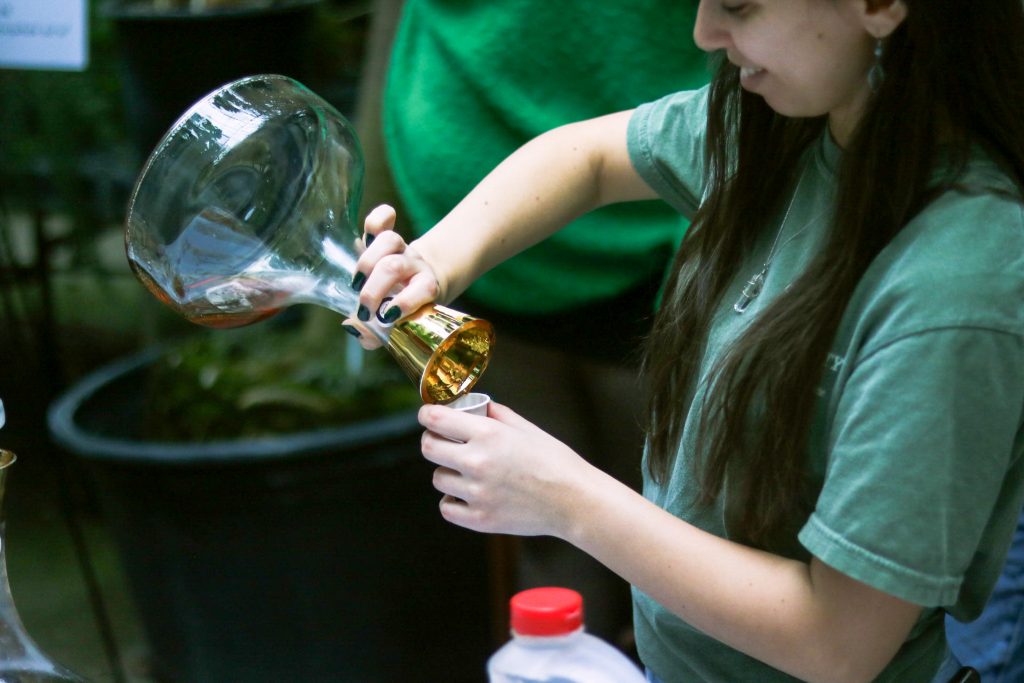Binghamton University’s Environmental Studies department held its third-annual Maple Syrup Day.
On Friday, various homemade syrups were displayed in the E.W. Heier Teaching Greenhouse in Science III. The syrups, organized by tone from light to dark, were made from start to finish by students in Environmental Studies 336: Sweet Harvest: Bees and Maple. The course is taught by Sara Velardi, an instructor in the Environmental Studies Department, who has organized Maple Day twice previously, with the first time being in Spring 2020.
The event features student research and data collection that starts at the beginning of the spring. It falls around the same time as New York State’s Maple Syrup weekend, which occurs during the last two weekends of March.
Students tabled inside the Greenhouse from 10 a.m. to 2 p.m. The event was originally scheduled to be held outdoors near the Spine, but was relocated due to weather. Signage was used to explain the research conducted and types of syrup on the table. Students offered distinct flavors of maple syrups for spectators to try, ranging from light amber to more thicker, bolder tones.
Velardi elaborated on how students make syrup, from tapping trees on campus to boiling the sap.
“We collect sap from a maple grove on campus, near the ropes course by East Gym,” Velardi said. “At first, that’s only 2 to 3 percent sugar. Then, you boil down the sap until it gets to around 66 percent [sugar]. We try to do a boil every weekend. From there, it’s really just an evaporation process, trying to get rid of all the excess water from the sap that comes directly from the tree.”
Velardi explained that a dozen trees were tapped this year as part of the project. Students were assigned specific trees throughout the semester to collect sap from once a week. The varying shades in the final product result from differences in tree characteristics, temperature and other factors, according to Velardi.
Velardi said she finds it important for students to understand and interact with natural resources on campus.
“I think there’s a lot of value in learning a skill to make something from nature,” Velardi said. “A lot of my students come out of this class saying, ‘Oh, this is something I can do at home. This is something I can do with my family.’ Many students also enjoy being outside during the day and being around the trees.”
Students in the class attended the event to display their results and talk about the process with student attendees. Matthew Baker, a senior majoring in environmental studies, shared his instructor’s sentiment when describing why he enjoys the course.
“As students, we’re used to being locked in our classes [during lecture],” Baker said. “Being a senior, I wanted to take classes that were more fun and interesting. Here, we work hands-on with maple trees and learn all about the process. I like going down and collecting the sap to see how much my tree has made. I even got to name my tree, Frank. Overall, I love being able to get outside.”
While students collect sap from the trees frequently, the amount of sap collected can vary week to week. Baker outlined two main factors that can contribute to sap production in the maple trees.
“It’s all about temperature and pressure,” Baker said. “In Binghamton, we have some hot days, and then a lot of really cold days. Those temperature differences allow the sap to flow up and down the tree. Sometimes, I’ll come back and there will be buckets full of sap. But other times, there will barely be any at all.”
During the day, students passing by walked into the Greenhouse, where mall sample cups were filled with different syrups available for attendees to try out.
Colleen Duggan, an undeclared freshman who attended the event, said she enjoyed trying the homemade syrups.
“I came over here to see the Greenhouse for the first time,” Duggan said. “I thought it was really cool, and I would like more people to know about it. I enjoyed trying the different types of maple syrup. It is interesting to see how their syrup compares to brand-name syrup that we buy in grocery stores.”



